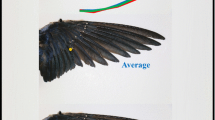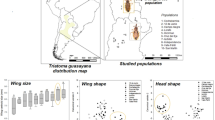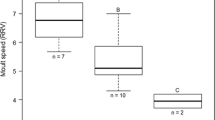Abstract
Body size influences wing shape and associated muscles in flying animals which is a conspicuous phenomenon in insects, given their wide range in body size. Despite the significance of this, to date, no detailed study has been conducted across a group of species with similar biology allowing a look at specific relationship between body size and flying structures. Neotropical social vespids are a model group to study this problem as they are strong predators that rely heavily on flight while exhibiting a wide range in body size. In this paper we describe the variation in both wing shape, as wing planform, and mesosoma muscle size along the body size gradient of the Neotropical social wasps and discuss the potential factors affecting these changes. Analyses of 56 species were conducted using geometric morphometrics for the wings and lineal morphometrics for the body; independent contrast method regressions were used to correct for the phylogenetic effect. Smaller vespid species exhibit rounded wings, veins that are more concentrated in the proximal region, larger stigmata and the mesosoma is proportionally larger than in larger species. Meanwhile, larger species have more elongated wings, more distally extended venation, smaller stigmata and a proportionally smaller mesosoma. The differences in wing shape and other traits could be related to differences in flight demands caused by smaller and larger body sizes. Species around the extremes of body size distribution may invest more in flight muscle mass than species of intermediate sizes.





Similar content being viewed by others
References
Abrol DP, Kapil RP (1994) On homing ability and pollination effectiveness of bees. Mysore J Agric Sci 28:249–252
Adams DC, Rohlf FJ, Slice DE (2004) Geometric morphometrics: ten years of progress following the ‘revolution’. Ital J Zool 71:5–16
Altshuler DL, Dudley R, McGuire JA (2004) Resolution of a paradox: hummingbird flight at high elevation does not come without a cost. Proc Natl Acad Sci USA 101:17731–17736
Aono H, Liang F, Liu H (2008) Near- and far-field aerodynamics in insect hovering flight: an integrated computational study. J Exp Biol 211:239–257
Ashraf EM (ed) (2010) Morphometrics–morphometrics for nonmorphometricians. Springer, Heidelberg
Birch JM, Dickson WB, Dickson MH (2004) Force production and flow structure of the leading edge vortex on flapping wings at high and low Reynolds numbers. J Exp Biol 207:1063–1072
Björklund M (1994) The independent contrast method in comparative biology. Cladistics 10:425–433
Boyle WA, Conway CJ (2007) Why migrate? A test of the evolutionary precursor hypothesis. Am Nat 169:344–359
Bullock S (1999) Relationships among body size, wing size and mass in bees from a tropical dry forest in Mexico. J Kansas Entomol Soc 72:426–439
Combes SA, Daniel TL (2003) Into thin air: contributions of aerodynamic and inertial- elastic forces to wing bending in hawkmoth Manduca sexta. J Exp Biol 206:2999–3006
Damus MS, Otis GW (1997) A morphometric analysis of Apis cerana and Apis nugrocincta Smith populations from Southeast Asia. Apidologie 28:309–323
Danforth B (1989) The evolution of hymenopteran wings: the importance of size. J Zool Lond 218:247–276
Daniel T, Tu MS (1999) Animal movement, mechanical tuning and coupled systems. J Exp Biol 202:3415–3421
Darveau CH, Hochachka APW, Welch KC, Roubik DW, Suarez RK (2005) Allometric scaling of flight energetics in Panamanian orchid bees: a comparative phylogenetic approach. J Exp Biol 208:3581–3591
Díaz-Uriarte R, Garland T (1996) Testing hypotheses of correlated evolution using phylogenetically independent contrasts: sensitivity to deviations from brownian motion. Syst Biol 45:27–47
Dickinson MH, Lehmann FO, Sane S (1999) Wing rotation and the aerodynamic basis of insect flight. Science 284:1954–1960
Diniz-Filho J (2000) Métodos filogenéticos comparativos. Holos editora, Riberao Preto
Dohrmann M, Janussen D, Reitner J, Collins AG, Worheide G (2008) Phylogeny and evolution of glass sponges (Porifera, Hexactinellida). Syst Biol 57:388–405
Dudley R (2001) The biomechanics and functional diversity of flight. In: Woiwod IP, Reynolds DR, Thomas CD (eds) Insect movement: mechanisms and consequences. CABI, Cambridge
Dudley R (2002) The biomechanics of insect flight. Princeton University Press, Princeton
Ellington CP (1984) The aerodynamics of hovering insect flight. II. Morphological parameters. Phil Trans R Soc Lond B 305:17–40
Ennos AR (1989) The effect of size on the optimal shapes of gliding insects and seeds. J Zool Lond 219:61–69
Felsenstein J (1985) Phylogenies and the comparative method. Am Nat 125:1–15
Felsenstein J (2008) Comparative methods with sampling error and within-species variation: contrasts revisited and revised. Am Nat 171:713–725
Gathmann A, Tscharntke T (2002) Foraging ranges of solitary bees. J Anim Ecol 71:757–764
Greenleaf SS, Williams NM, Winfree R, Kremen C (2007) Bee foraging ranges and their relationship to body size. Oecologia 153:589–596
Guédot C, Bosch J, Kemp WP (2009) Relationship between body size and homing ability in the genus Osmia (Hymenoptera; Megachilidae). Ecol Entomol 34:158–161
Harvey P, Pagel M (1991) The comparative method in evolutionary biology. Oxford University Press, Cambridge
Jeanne R (1991) The swarm-founding Polistinae. In: Ross R, Matthews R (eds) The social biology of wasps. Cornell University Press, Ithaca, pp 191–231
Johansson F, Söderquist M, Bokma F (2009) Insect wing shape evolution: independent effects of migratory and mate guarding flight on dragonfly wings. Biol J Linn Soc 97:362–372
Kaboli M, Aliabadian M, Guillaumet A, Roselaar CS, Prodon R (2007) Ecomorphology of the wheatears (genus Oenanthe). Ibis 149:792–805
Klowden MJ (2002) Physiological systems in insects. Academic Press, San Diego
Kluge A (2005) Testing lineage and comparative methods for inferring adaptation. Zool Scr 34:653–663
Knight ME, Martin AP, Bishop S, Osborne JL, Hale RJ, Sanderson RA, Goulson D (2005) An interspecific comparison of foraging range and nest density of four bumblebee (Bombus) species. Mol Ecol 14:1811–1820
Kolm N, Stein RW, Mooers AO, Verspoor JJ, Cunningham EJA (2007) Can sexual selection drive female life histories? A comparative study on Galliform birds. J Evol Biol 20:627–638
Lamborot M, Eaton L (1997) The Maipo river as a biogeographical barrier to Liolaemus monticola (Tropiduridae) in the mountain ranges of central Chile. J Zool Syst Evol Res 35:105–111
Lissaman PBS (1983) Low-Reynolds-number airfoils. Ann Rev Fluid Mech 15:223–240
Luo G, Suo M (2005) The effects of corrugation and wing planform on the aerodynamic force production of sweeping model insect wings. Acta Mec Sinica 21:531–541
Marcus LF, Corti M, Loy A, Naylor G, Slice D (1996) Advances in morphometrics. Plenum Press, New York
Martins EP (2004) COMPARE, version 4.6b. Computer programs for the statistical analysis of comparative data. Distributed by the author at http://compare.bio.indiana.edu/. Department of Biology, Indiana University, Bloomington IN
Martins EJ, Diniz-Filho A, Housworth E (2002) Adaptive constrains and the phylogenetic comparative method: a computer simulation test. Evolution 56:1–13
McMahon TA, Bonner JT (1983) On size and life. Scientific American Library, New York
Njabo KY, Bowie RCK, Sorenson MD (2008) Phylogeny, biogeography and taxonomy of the African wattle-eyes (Aves: Passeriformes: Platysteiridae). Mol Phylog Evol 48:136–149
Noll FB, Wenzel JW, Zucchi R (2004) Evolution of caste in Neotropical swarm-founding wasps (Hymenoptera: Vespidae; Epiponini). Am Mus Novit 3467:1–24
Norberg UM (1989) Vertebrate flight, mechanics, physiology, morphology, ecology and evolution. Springer, Berlin
Oster G, Wilson EO (1978) Caste and ecology in the social insects. Princeton University Press, Princeton
Raw A (1998) Population densities and biomass of Neotropical social wasps (Hymenoptera, Vespidae) related to colony size, hunting range and wasps size. Revta Bras Zool 15(3):815–822
Rodríguez A, Sarmiento CE (2008) Altitudinal distribution and body resource allocation in a high mountain social wasp (Hymenoptera: Vespidae). Neotr Entomol 37:1–7
Rohlf J (2005a) Tps utility program version 1.33. Ecology and Evolution, SUNY at Stony Brook. Available at http://life.bio.sunysb.edu/morph/
Rohlf J (2005b) Tps dig, version 2,04. Ecology and Evolution, SUNY at Stony Brook. Available at http://life.bio.sunysb.edu/morph/
Rohlf J (2005c) Tps relative warps version 1.42. Ecology and Evolution, SUNY at Stony Brook. Available at http://life.bio.sunysb.edu/morph/
Sane S (2003) The aerodynamics of insect flight. J Exp Biol 206:4191–4208
Snodgrass RE (1935) Principles of insect morphology. McGraw Hill Company, New York
Somers KM (1986) Multivariate allometry and removal of size with principal components analysis. Syst Zool 35:359–368
Statsoft Inc (2001) STATISTICA (data analysis software system), version 6. http://www.statsoft.com
Tsuyuki K, Sudo S, Tani J (2006) Morphology of insect wings and airflow produced by flapping insects. J Intel Mat Syst Struct 17:743–751
Usherwood JR, Ellington CP (2002) The aerodynamics of revolving wings I. Model hawkmoth wing. J Exp Biol 205:1547–1564
van Nieuwstadt MGL, Ruano Iraheta CE (1996) Relation between size and foraging range in stingless bees (Apidae, Meliponinae). Apidologie 27:219–228
Walker JA (2002) Functional morphology and virtual models: physical constraints on the design of oscillating wings, fins, legs and feet at intermediate Reynolds numbers. Integr Comp Biol 42:232–242
Wenzel JW, Carpenter JM (1994) Comparing methods: adaptive traits and tests of adaptation. In: Eggleton P, Vane-Wright RI (eds) Phylogenetics and ecology. Academic Press, London, pp 79–101
Wootton R (1981) Support and deformability in insect wings. J Zool London 193:447–468
Wootton R (1992) Functional morphology of insect wings. Annu Rev Entomol 37:113–140
Wootton R (2001) How insects wings evolved. In: Woiwod IP, Reynolds DR, Thomas CD (eds) Insect movement: mechanisms and consequences. CABI, Cambridge
Zelditch ML, Swiderski DL, Sheets DH, Fink W (2004) Geometrics morphometrics for biologist: a primer. Elsevier Academic Press, London
Acknowledgments
The authors thank A. Amarillo, E. Martins, R. Dudley, J. Billen, H. Wang, F. Noll, J. Carpenter, K. Pickett, T. Harwell, and the anonymous reviewers for their comments. Ronald Frisk improved the writing. This research was supported by the Sciences College and the Instituto de Ciencias Naturales of the Universidad Nacional de Colombia, the Colombian National Parks Unit, the Alexander von Humboldt Institute, Colombia, and the National Science Foundation grants DEB 9972024 and 0205982 to M. Sharkey and B. Brown. We thank Carolina Medellin for the drawings.
Author information
Authors and Affiliations
Corresponding author
Additional information
Communicated by T. Bartolomaeus.
Electronic supplementary material
Below is the link to the electronic supplementary material.
Rights and permissions
About this article
Cite this article
García, Z., Sarmiento, C.E. Relationship between body size and flying-related structures in Neotropical social wasps (Polistinae, Vespidae, Hymenoptera). Zoomorphology 131, 25–35 (2012). https://doi.org/10.1007/s00435-011-0142-z
Received:
Revised:
Accepted:
Published:
Issue Date:
DOI: https://doi.org/10.1007/s00435-011-0142-z




